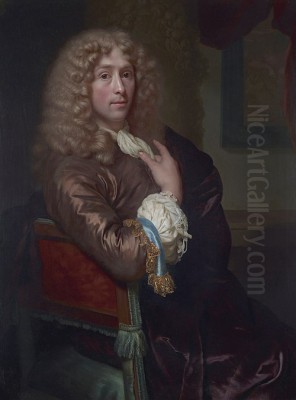
Godfried Schalcken stands as a distinctive figure in the twilight years of the Dutch Golden Age of painting. Active during the latter half of the 17th century and into the early 18th, he carved a unique niche for himself, becoming renowned across Europe, particularly for his evocative and technically brilliant depictions of scenes illuminated by artificial light, most famously candlelight. While also a skilled portraitist and painter of biblical and mythological subjects, it is his mastery of chiaroscuro and the intimate, often sensual, atmosphere of his nocturnal genre scenes that cemented his legacy. His work bridges the meticulous detail of the Leiden ‘fijnschilders’ (fine painters) with a burgeoning interest in mood, emotion, and the suggestive power of shadow.
Born in 1643 in Made, a village near the prominent Dutch town of Dordrecht, Godfried Schalcken (sometimes spelled Godfridus Schalcken) entered a world steeped in religious and intellectual pursuits. His father served as a pastor and later as the rector of the Latin school in Dordrecht, suggesting a family environment where education and piety were valued. This background perhaps subtly informs the often restrained, yet emotionally charged, nature of his later works. The family relocated to Dordrecht itself in 1654, placing the young Godfried in one of the key artistic centres of the Netherlands, a city that had fostered talents like Aelbert Cuyp and Nicolaes Maes.
Early Life and Foundational Training
Schalcken's formal artistic education began around 1656, when he entered the studio of Samuel van Hoogstraten in Dordrecht. This apprenticeship, lasting until about 1662, was formative. Van Hoogstraten was himself a multifaceted artist – a painter, poet, and art theorist – who had studied directly under Rembrandt in Amsterdam. Through Van Hoogstraten, Schalcken would have been exposed indirectly to Rembrandt's profound influence, particularly his dramatic use of light and shadow and his interest in psychological depth, even if Van Hoogstraten's own style evolved considerably over his career, exploring perspective boxes and trompe-l'oeil effects alongside more conventional painting.
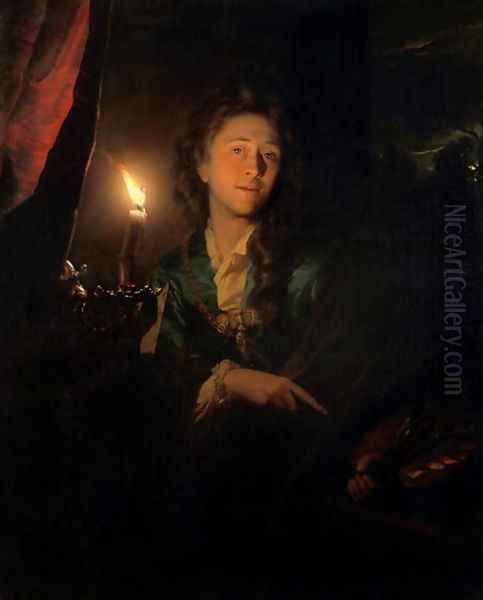
Seeking further refinement and perhaps drawn by the stellar reputation of another Rembrandt pupil, Schalcken moved to Leiden after completing his training with Van Hoogstraten. There, he entered the workshop of Gerard Dou (also known as Gerrit Dou) around 1662. Dou was arguably the most famous of Rembrandt's Leiden students and the founder of the Leiden 'fijnschilder' school. This school emphasized meticulous detail, smooth surfaces devoid of visible brushstrokes, and often depicted intimate interior scenes. Studying with Dou, likely until about 1664 or 1665, profoundly impacted Schalcken's technique.
The influence of Dou is readily apparent in Schalcken's early works. He adopted the smooth finish, the careful rendering of textures (like velvet, satin, and metal), and the small scale often favoured by the Leiden school. Leiden at this time was a hub for 'fijnschilders', including artists like Frans van Mieris the Elder and Pieter Cornelisz van Slingelandt, whose works shared this emphasis on exquisite craftsmanship and detailed realism. Schalcken absorbed these qualities, mastering the demanding techniques required to achieve such a high level of finish.
Developing a Signature Style: The Allure of Artificial Light
While Schalcken learned much from Dou, he soon began to forge his own path. He returned to Dordrecht sometime in the mid-1660s and established himself as an independent master. It was during this period, and increasingly through the 1670s and 1680s, that he developed his signature specialty: scenes illuminated by artificial light sources, predominantly candles, but also oil lamps or lanterns. While Dou and other Leiden painters occasionally depicted candlelit scenes, Schalcken made it his trademark, exploring its atmospheric and narrative possibilities with unparalleled dedication.
His candlelight paintings are characterized by a dramatic interplay of light and shadow (chiaroscuro). Often, a single candle held by a figure or placed strategically within the composition serves as the primary light source. This light brightly illuminates nearby faces, hands, and objects, while plunging the surrounding areas into deep, velvety darkness. This technique allowed Schalcken to focus the viewer's attention, create a sense of intimacy and enclosure, and imbue his scenes with a palpable mood, ranging from quiet contemplation to playful seduction or even eerie suspense.
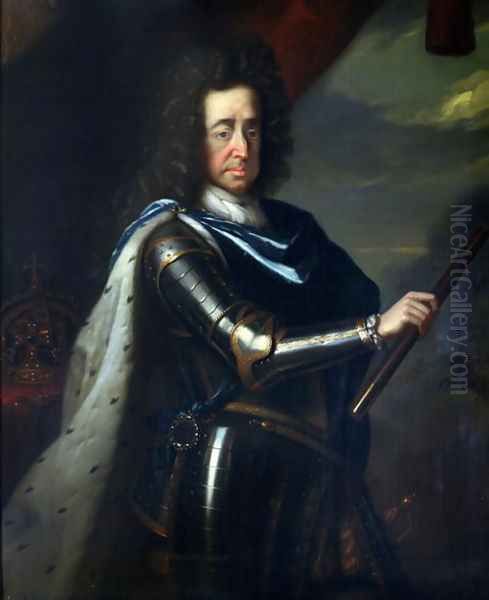
Schalcken's handling of light was exceptionally refined. He masterfully captured the warm glow of the flame, the soft diffusion of light on skin and fabric, the sharp highlights on reflective surfaces like metal or glass, and the subtle gradations of shadow. Unlike the often harsh, dramatic contrasts found in the work of earlier Caravaggisti or even some of Rembrandt's works, Schalcken's chiaroscuro tends to be softer, more elegant, and focused on creating a specific, often sensual or romantic, atmosphere. His colours in these scenes are typically warm, dominated by reds, golds, and browns, enhancing the feeling of warmth emanating from the artificial light.
The subjects of these signature pieces were often genre scenes featuring one or a few figures, frequently young women. Titles like Young Woman with a Candle or Girl Threading a Needle by Candlelight are typical. These scenes often carry subtle erotic undertones – a woman undressing by candlelight, a couple in intimate conversation, or figures engaged in activities associated with courtship or seduction, like playing music or examining jewellery. However, Schalcken usually maintained a sense of decorum and elegance, avoiding overt vulgarity. The allure lies in the suggestion, the intimacy implied by the shared light in the surrounding darkness.
The Candlelight Specialist: Technique and Themes
Schalcken's dedication to the effects of artificial light set him apart. While artists like Georges de La Tour in France had explored candlelight with profound spiritual intensity earlier in the century, and Rembrandt had masterfully used light for dramatic and psychological effect, Schalcken approached it with a different sensibility. His focus was often on the refinement of technique, the creation of mood, and the depiction of intimate, often secular, moments. He became, in essence, the specialist painter of candlelight for the late Dutch Golden Age.
His technical approach involved meticulous layering of thin glazes of paint to achieve the smooth finish and luminous effects characteristic of his work, a legacy of his Leiden training. He paid extraordinary attention to the way light interacted with different surfaces – the soft absorption of light by velvet, the sharp gleam on a brass candlestick, the translucent glow through a wine glass. This careful observation and rendering contributed significantly to the realism and tactile quality of his paintings.
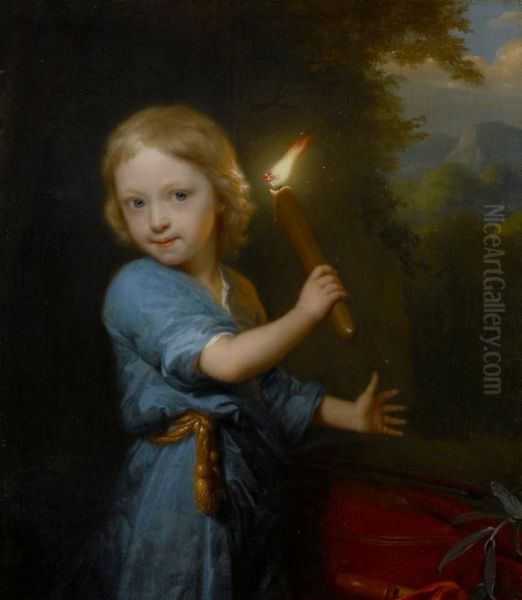
Beyond simple genre scenes, Schalcken applied his candlelight technique to biblical and mythological subjects. Stories like the Parable of the Wise and Foolish Virgins, Salome receiving the head of John the Baptist, or Ceres searching for Proserpina provided narrative contexts for dramatic nocturnal lighting. These works often possess a heightened sense of drama or mystery compared to his more straightforward genre pieces. He also painted allegorical scenes and portraits where the sitter might be shown holding a candle or illuminated by one, adding a layer of intimacy or symbolic meaning.
His self-portraits, too, sometimes employed this device, reinforcing his public image as the 'Master of Candlelight'. By depicting himself within the type of scene he was famous for, he engaged in a form of self-marketing, aligning his personal identity with his artistic brand. This awareness of the art market and his own reputation was characteristic of successful artists of the period.
Career Progression and Relocation to The Hague
Schalcken worked successfully in Dordrecht for roughly two decades after returning from Leiden. He gained considerable recognition and presumably financial success, attracting patrons who appreciated his refined style and unique specialty. His reputation grew steadily, extending beyond his native city.
In 1691, seeking perhaps greater opportunities or a more prestigious environment, Schalcken relocated to The Hague. At that time, The Hague was the centre of government and court life in the Dutch Republic, attracting diplomats, wealthy burghers, and international visitors. It was also home to a thriving community of artists, including portraitists catering to the elite. This move marked a significant step in his career, placing him closer to potential high-status patrons.
Some art historians suggest that Schalcken's style may have evolved during his Hague period, perhaps becoming somewhat bolder or broader in handling, particularly in larger-scale works like portraits, moving slightly away from the extreme microscopic detail of his earliest Leiden-influenced phase. However, he certainly continued to produce the candlelight scenes that were his claim to fame, as these remained highly sought after by collectors. His time in The Hague solidified his position as one of the leading Dutch painters of his generation.
London Sojourn and International Acclaim
Schalcken's growing reputation led to opportunities abroad. Around 1692, he travelled to London, where he would remain for approximately six years, until about 1698. This period significantly enhanced his international standing. England, particularly London, was an attractive destination for continental artists, offering potential patronage from the aristocracy and the court.

The most prestigious commission Schalcken received during his London stay was from King William III, who was also the Stadtholder of the Dutch Republic. Schalcken painted a portrait of the King by candlelight, a work now housed in the Rijksmuseum in Amsterdam. This royal commission was a major coup, significantly boosting his prestige. Working in London, he would have been aware of, and perhaps competed with, established portrait painters like Sir Godfrey Kneller and Michael Dahl, who dominated the English market.
His distinctive candlelight scenes found favour with English collectors, who appreciated their novelty and intimate charm. The sensory, sometimes subtly erotic, nature of his genre paintings appealed to the tastes of the era. During this time, or perhaps shortly before or after, he also secured patronage from another major European figure, Cosimo III de' Medici, the Grand Duke of Tuscany, for whom he painted works, further cementing his international reputation. Florence, under the Medici, was a major centre for art collection, and commissions from such patrons were highly valued.
Despite his artistic success in London, contemporary accounts, particularly those by the Dutch biographer Arnold Houbraken (who wrote shortly after Schalcken's death), suggest that Schalcken's personality may have hindered his social integration. He is described as having a somewhat coarse or difficult temperament, being avaricious, and lacking polished manners, which reportedly led to some friction or exclusion within London's elite circles. While Houbraken's accounts often contain anecdotal embellishments, the recurring theme suggests Schalcken may not have been the most socially adept figure.
Later Years and Enduring Themes
After his productive and reputation-enhancing stay in London, Schalcken returned to The Hague around 1698, where he remained active until his death in 1706. He continued to enjoy considerable success, his works commanding high prices. He painted portraits of prominent citizens, such as the wealthy Leiden merchant and collector Pieter de la Court van der Voort, demonstrating his continued connection to elite patronage networks.
He persisted in painting his signature candlelight scenes, which remained popular throughout his career. However, he also produced daylight genre scenes, historical paintings, and portraits. Some critics, like Jacob Campo Weyerman writing later in the 18th century, offered a mixed assessment of Schalcken's later work. Weyerman, known for his often sharp and biased commentary, praised the candlelight scenes but disparaged some of Schalcken's larger portraits, famously describing one as "flat as an unleavened pancake." Weyerman accused Schalcken of sometimes prioritizing commercial appeal (the popular candlelight nocturnes) over more ambitious works. Such criticisms reflect the changing tastes and critical standards of the 18th century, but also highlight the enduring association of Schalcken with his specific niche.
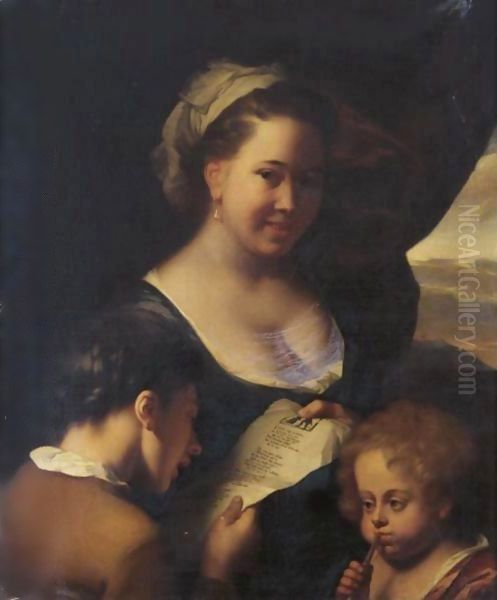
His repertoire continued to include biblical and mythological themes interpreted through his characteristic lens. Works depicting subjects like Pygmalion admiring his statue by lamplight, or Venus accompanying Cupid, allowed him to blend classical narrative with his interest in intimate, dramatically lit settings, often exploring themes of love, creation, and desire.
Personal Life, Character, and Workshop
Schalcken married Françoise van Diemen (Fransyne van Diemen) in Dordrecht in 1679. The couple reportedly had seven children, but tragically, according to sources like Houbraken, only one daughter, also named Françoise, survived to adulthood. This high rate of child mortality was unfortunately common in the 17th century. His family background remained rooted in the Dutch Reformed Church, given his father's profession.
As mentioned, contemporary accounts paint a picture of Schalcken as having a somewhat difficult personality. Houbraken describes him as rough-mannered and overly concerned with money. Another anecdote, possibly apocryphal or exaggerated, involves a difficult romantic entanglement with a young woman named Rose Veldk (or a similar name), sometimes identified as his niece, which supposedly ended tragically. While the veracity of such stories is hard to ascertain, they contribute to the image of a complex individual whose personal life may have had its share of turmoil, contrasting with the often serene or elegantly sensual mood of his paintings.
Like most successful painters of his time, Schalcken likely maintained a workshop and trained pupils, although documentation is not extensive. His sister, Maria Schalcken (c. 1645/49 - before 1699), was also a painter and is believed to have studied with him, producing works in a similar style. Other documented or attributed pupils include Arnold Boonen (though Boonen also studied elsewhere), Anthony Vreem (active c. 1675-1681), Carel de Loo (active in The Hague in the 1680s), and Arent Pijp (c. 1680-1721). The existence of numerous copies and variations of his popular compositions suggests an active studio practice meeting market demand.
Legacy, Influence, and Collections
Godfried Schalcken died in The Hague in 1706, leaving behind a significant body of work and a distinct artistic legacy. His primary contribution lies in his specialization in, and mastery of, scenes illuminated by artificial light. He elevated this type of scene beyond mere novelty, using candlelight to explore atmosphere, intimacy, and subtle psychological states. His technical finesse, inherited from the Leiden tradition but applied to his unique thematic concerns, was widely admired.
His influence can be seen in the work of some of his contemporaries and followers who also tackled nocturnal scenes. While perhaps not founding a major 'school' in the way Dou did, his success demonstrated the market appeal of such subjects. His elegant style and focus on intimate, sometimes mildly erotic, genre themes can be seen as anticipating aspects of 18th-century Rococo sensibilities. Furthermore, his emphasis on mood and the evocative power of light and shadow connects him to later developments, including the atmospheric concerns of Romanticism. Artists like Joseph Wright of Derby in England, famous for his dramatic scenes of science and industry lit by artificial light in the later 18th century, arguably owe a debt to the tradition Schalcken popularized.
Schalcken's paintings were highly prized by collectors during his lifetime and remained popular throughout the 18th and 19th centuries. Today, his works are held in major museums across the world. Significant collections can be found in:
The Rijksmuseum, Amsterdam (including the portrait of William III)
The Mauritshuis, The Hague
The Royal Collection Trust, UK (including Lady, Come into the Garden at Buckingham Palace and other works)
The National Gallery, London
The Louvre Museum, Paris
The Alte Pinakothek, Munich (including a notable Self-Portrait)
The Gemäldegalerie Alte Meister, Dresden
The Dordrechts Museum, Dordrecht (fittingly, given his origins)
The Museum of Fine Arts, Boston
Various other European and American museums, as well as private collections.
A recent event highlighting the enduring value and sometimes complex provenance of his work was the restitution of his Portrait of an Elderly Gentleman with a Cane to a Polish museum collection after it had been missing since World War II.
Conclusion: An Enduring Glow
Godfried Schalcken remains a fascinating figure in Dutch art history. He successfully navigated the competitive art market of the late Golden Age by cultivating a unique and highly skilled specialty. His candlelight paintings, with their blend of meticulous Leiden technique, dramatic chiaroscuro, and intimate, often sensual, atmosphere, offer a distinct perspective within the broader spectrum of 17th-century Dutch art. While perhaps overshadowed in popular consciousness by giants like Rembrandt or Vermeer, Schalcken's mastery of light and mood, his ability to capture the subtle glow of a candle flame and the world it illuminates, secured him a lasting place in the canon. His work continues to intrigue viewers with its technical brilliance, its evocative power, and the quiet, sometimes mysterious, stories unfolding in the soft, warm light surrounded by deep shadow. He was, truly, the master of candlelight.